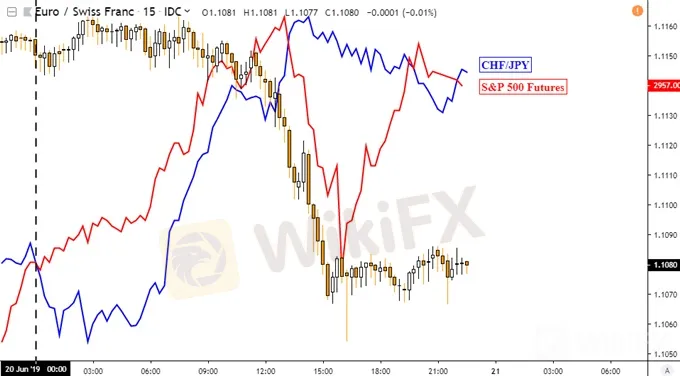简体中文
繁體中文
English
Pусский
日本語
ภาษาไทย
Tiếng Việt
Bahasa Indonesia
Español
हिन्दी
Filippiiniläinen
Français
Deutsch
Português
Türkçe
한국어
العربية
Franc Gains as EURCHF, USDCHF Sink. US Dollar Rising Support Held
Abstract:The Swiss Franc outperformed, EURCHF, USDCHF tumbled with US-Iran tension fears. While the Dollar extended declines, it was unable to breach rising support from September 2018.
Asia Pacific Market Open Talking Points
Anti-risk Swiss Franc outperforms, even against the Japanese Yen
US Dollar extends declines but unable to breach rising support again
S&P 500 futures pointing lower, pro-risk AUD and NZD may fall
Trade all the major global economic data live as it populates in the economic calendar and follow the live coverage for key events listed in the DailyFX Webinars. Wed love to have you along.
The anti-risk Swiss Franc outperformed against its major counterparts on Thursday despite an overall uptick in sentiment, even outperforming the similarly-behaving Japanese Yen. Franc gains picked up against the Yen heading into the European trading session as Nikkei 225 and S&P 500 futures pushed higher in the aftermath of a dovish Fed interest rate announcement, perhaps reflecting Yen-based carry demand.
Then, EURCHF sunk and closed at its lowest since July 2017 on the 15-minute chart below. Equities cautiously retreated on US-Iran tension fears during the Wall Street trading session. US President Donald Trump tweeted that we will “soon find out” if the nation will strike Iran after it reportedly shot down a US drone. USDCHF closed at its lowest since the beginning of this year.
EURCHF 15-Minute Chart

Speaking of the US Dollar, the Greenback continued depreciating and was the worst-performing major. It tracked ongoing declines in US government bond yields as the markets confidently price in the first Fed rate cut since 2008 next month. The S&P 500 closed eight points above highs in April, making for a new record as the Dow Jones rose about one percent.
US Dollar Technical Analysis
The DXY, while succumbing to selling pressure, was unable to clear the rising trend line from September 2018 on the daily chart below. This continues to further solidify support. Meanwhile, positive RSI divergence shows fading downside momentum which can precede a turn higher. Near-term resistance appears to be around 97.52.
DXY Daily Chart

*Chart Created in TradingView
Friday Asia Pacific Session
Disclaimer:
The views in this article only represent the author's personal views, and do not constitute investment advice on this platform. This platform does not guarantee the accuracy, completeness and timeliness of the information in the article, and will not be liable for any loss caused by the use of or reliance on the information in the article.
Read more

KVB Market Analysis | 30 August: JPY Strengthens Against USD Amid Strong Q2 GDP and BoJ Rate Hike Speculation
The Japanese Yen (JPY) strengthened against the US Dollar (USD) on Thursday, boosted by stronger-than-expected Q2 GDP growth in Japan, raising hopes for a BoJ rate hike. Despite this, the USD/JPY pair found support from higher US Treasury yields, though gains may be capped by expectations of a Fed rate cut in September.

KVB Market Analysis | 28 August: Yen Strengthens on BoJ Rate Hike Hints; USD/JPY Faces Uncertainty
The Japanese Yen rose 0.7% against the US Dollar after BoJ Governor Kazuo Ueda hinted at potential rate hikes. This coincided with a recovery in Asian markets, aided by stronger Chinese stocks. With the July FOMC minutes already pointing to a September rate cut, the US Dollar might edge higher into the weekend.

KVB Market Analysis | 27 August: AUD/USD Holds Below Seven-Month High Amid Divergent Central Bank Policies
The Australian Dollar (AUD) traded sideways against the US Dollar (USD) on Tuesday, staying just below the seven-month high of 0.6798 reached on Monday. The downside for the AUD/USD pair is expected to be limited due to differing policy outlooks between the Reserve Bank of Australia (RBA) and the US Federal Reserve. The RBA Minutes indicated that a rate cut is unlikely soon, and Governor Michele Bullock affirmed the central bank's readiness to raise rates again if necessary to combat inflation.

KVB Market Analysis | 23 August: JPY Gains Ground Against USD as BoJ Signals Possible Rate Hike
JPY strengthened against the USD, pushing USD/JPY near 145.00, driven by strong inflation data and BoJ rate hike expectations. Japan's strong Q2 GDP growth added support. However, USD gains may be limited by expectations of a Fed rate cut in September.
WikiFX Broker
Latest News
Exposing the Top 5 Scam Brokers of March 2025: A Closer Look by WikiFX
Gold Prices Climb Again – Have Investors Seized the Opportunity?
Webull Launches SMSF Investment Platform with Zero Fees
Australian Regulator Warns of Money Laundering and Fraud Risks in Crypto ATMs
The Withdrawal Trap: How Scam Brokers Lure Victims into Paying More
FCA to Investors: Think Twice Before Trusting These Brokers
Trump\s tariffs: How could they affect the UK and your money
Trump gambles it all on global tariffs he\s wanted for decades
TradingView Brings Live Market Charts to Telegram Users with New Mini App
HTFX Spreads Joy During Eid Charity Event in Jakarta
Currency Calculator







